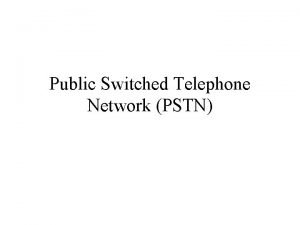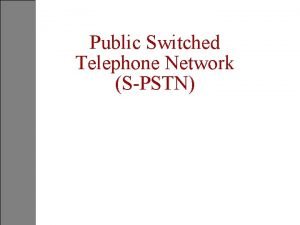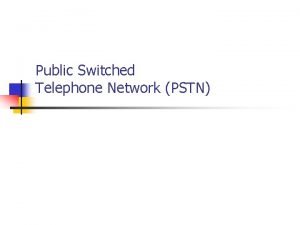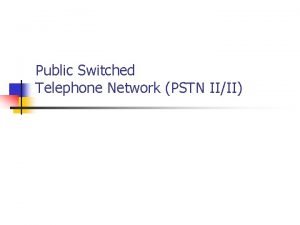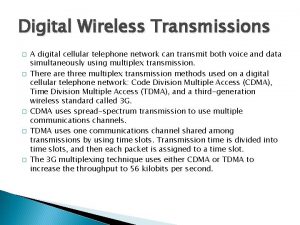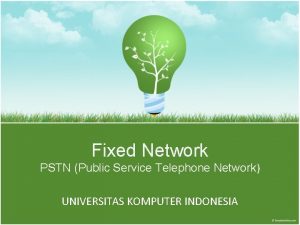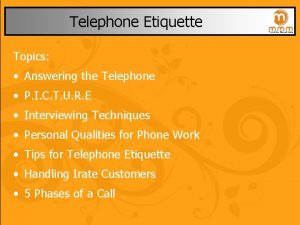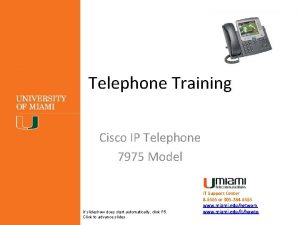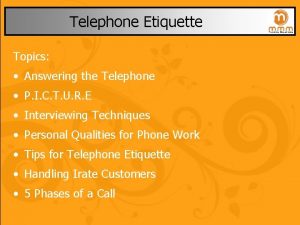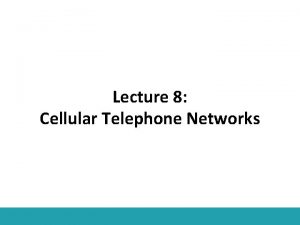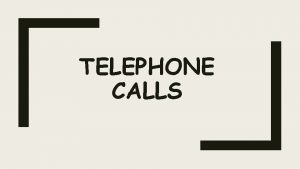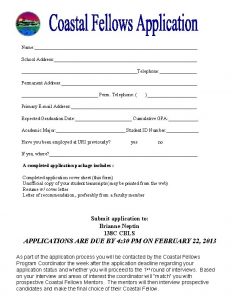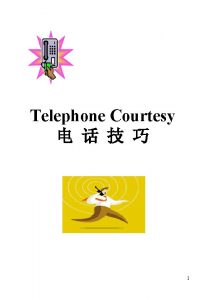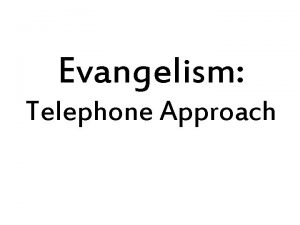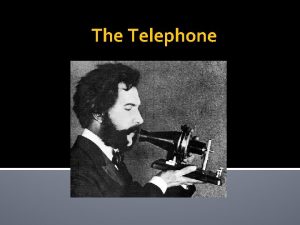How a Telephone and Telephone Network Work IS




















- Slides: 20

How a Telephone and Telephone Network Work IS 146: Foundations of New Media Prof. Marc Davis, Prof. Peter Lyman, and danah boyd UC Berkeley SIMS Tuesday and Thursday 2: 00 pm – 3: 30 pm Spring 2005 http: //www. sims. berkeley. edu/academics/courses/is 146/s 05/ IS 146 – SPRING 2005. 03. 01 SLIDE 1

Lecture Overview • Review of Last Time – Speech and Audio as Media • Today – How a Telephone and Telephone Network Work – Guest Lecturers: Michael Smith and Ndiata Kalonji • Preview of Next Time – The Telephone from Bell to Cellphones – Guest Lecture: Genevieve Bell IS 146 – SPRING 2005. 03. 01 SLIDE 2

Lecture Overview • Review of Last Time – Speech and Audio as Media • Today – How a Telephone and Telephone Network Work – Guest Lecturers: Michael Smith and Ndiata Kalonji • Preview of Next Time – The Telephone from Bell to Cellphones – Guest Lecture: Genevieve Bell IS 146 – SPRING 2005. 03. 01 SLIDE 3

Assignments, Grades, Questions • Assignment 3 is graded – Pick up at the end of class – More notes will be sent out after class • Grades • Questions about Assignment 4? • Midterm is coming up IS 146 – SPRING 2005. 03. 01 SLIDE 4

Readings for Next Time • Claude S. Fisher. America Calling: A Social History of the Telephone to 1940, Berkeley: University of California Press, 1994, p. 21 -29. • Claude S. Fisher. America Calling: A Social History of the Telephone to 1940, Berkeley: University of California Press, 1994, p. 33 -59. – Discussion Questions IS 146 – SPRING 2005. 03. 01 SLIDE 5

Ong on Orality • Orality (or “Primary Orality”) – The phase of oral culture prior to the advent of writing • Literacy – The phase from the invention of writing through the invention of the printing press up to before the advent of the first electronic communications technology • Secondary Orality – The phase from the invention of the telegraph to the present day and recovers some aspects of orality by connecting people across space through mediated interaction (e. g. , the telephone) • In the modern day, aspects of primary orality, literacy, and secondary orality all intertwine in our social uses of communication and communications technologies IS 146 – SPRING 2005. 03. 01 SLIDE 6

Ong on Orality • Oral communication produces sounds which have no record – • It is “evanescent” In the absence of external representations, primary orality requires internal cognitive structures to organize and store knowledge for retrieval – – – Rhythm Rhymes Aphorisms Epithets Memory palaces IS 146 – SPRING 2005. 03. 01 SLIDE 7

Lecture Overview • Review of Last Time – Speech and Audio as Media • Today – How a Telephone and Telephone Network Work – Guest Lecturers: Michael Smith and Ndiata Kalonji • Preview of Next Time – The Telephone from Bell to Cellphones – Guest Lecture: Genevieve Bell IS 146 – SPRING 2005. 03. 01 SLIDE 8

Information Theory • Quantitatively studies information flow: how people send and receive information • Meaning is irrelevant to information – Information measures uncertainty – Quantification of stimuli / signals – Measure of freedom in decision making • Yes/No question vs. Guess a word IS 146 – SPRING 2005. 03. 01 SLIDE 9

Noise • Interference in the signal – Systems adjust through redundancy • Games rely on noise – Fun is struggle against noise and uncertainty • Successful signal processing requires balancing noice and redundancy IS 146 – SPRING 2005. 03. 01 SLIDE 10

Infrmatn Spred • “Only infrmatn esentil to understandn mst b tranmitd” – Equivalent to SMS Speak • Adding noise for play: Az. N p. Ri. De – Ru. Lz 4 Sp. Ea. Ki. Ng – Aesthetics? Ownership? • Questioning redundancy IS 146 – SPRING 2005. 03. 01 SLIDE 11

Lecture Overview • Review of Last Time – Speech and Audio as Media • Today – How a Telephone and Telephone Network Work – Guest Lecturers: Michael Smith and Ndiata Kalonji • Preview of Next Time – The Telephone from Bell to Cellphones – Guest Lecture: Genevieve Bell IS 146 – SPRING 2005. 03. 01 SLIDE 12

Michael Smith and Ndiata Kalonji • Michael Smith directs the digital media partnership between France Telecom R&D and the University of California, Berkeley. A noted researcher in video analysis, he is the author of numerous papers and a book on the subject. His innovations include patented video analysis and summarization technology used by Sonic. Foundry and the OGIS Research Institute, Osaka. He holds a Ph. D in Electrical and Computer Engineering. • Ndiata Kalonji is the Director of Access and Core Networks at France Telecom IS 146 – SPRING 2005. 03. 01 SLIDE 13

Daniel Delmore • Weaver says that, "information is a measure of one's freedom of choice when one selects a message. ”. . . What are some examples of games that test the information theory and the description listed above? IS 146 – SPRING 2005. 03. 01 SLIDE 14

Daniel Delmore • Noise increases the uncertainty of the signal, and therefore the amount of information it contains. Is this concept of noise a good thing when it comes to information? Specifically is this a safe or not? In what context/environment is “noise” good to exist in? IS 146 – SPRING 2005. 03. 01 SLIDE 15

Daniel Arnold • Salen and Zimmerman generally define information as "a measure of how certain you can be about the nature of a signal, " emphasizing that the more uncertainty, the more information. Does this definition reduce the amount of information present in society? Given this definition, would you (still) consider people to be bombarded with information overload? IS 146 – SPRING 2005. 03. 01 SLIDE 16

Daniel Arnold • Assuming that information simply is based on uncertainty, would this decrease the reliability of information? How do we assign credibility if all information depends on uncertainty? IS 146 – SPRING 2005. 03. 01 SLIDE 17

Daniel Arnold • According to Salen and Zimmerman, "Noise increases the amount of information and uncertainty in a message. " How would noise increase the amount of information in any given message? Is not all the information of a message contained in the signal itself? How exactly, does background noise add information? IS 146 – SPRING 2005. 03. 01 SLIDE 18

Daniel Arnold • Given the separation of meaning and information, can meaning be labeled information when it contains some ambiguity? For instance, when a word can be defined in several different ways. IS 146 – SPRING 2005. 03. 01 SLIDE 19

Lecture Overview • Review of Last Time – Speech and Audio as Media • Today – How a Telephone and Telephone Network Work – Guest Lecturers: Michael Smith and Ndiata Kalonji • Preview of Next Time – The Telephone from Bell to Cellphones – Guest Lecture: Genevieve Bell IS 146 – SPRING 2005. 03. 01 SLIDE 20
 Public switched telephone network diagram
Public switched telephone network diagram Public switched telephone network diagram
Public switched telephone network diagram Pstn
Pstn Pstn
Pstn A satellite used in a cellular telephone network
A satellite used in a cellular telephone network Managing entity network management
Managing entity network management Pstn adalah singkatan dari
Pstn adalah singkatan dari Section 4 review physical science
Section 4 review physical science Origins of vc and datagram networks
Origins of vc and datagram networks Features of peer to peer network and client server network
Features of peer to peer network and client server network Network centric computing
Network centric computing Smart work vs hard work
Smart work vs hard work Physics 03-06 impulse and momentum answer key
Physics 03-06 impulse and momentum answer key Topology in computer
Topology in computer Ece 526
Ece 526 Packet switched network vs circuit switched
Packet switched network vs circuit switched Work incentives network oregon
Work incentives network oregon What is conflict in work immersion
What is conflict in work immersion Title for work immersion
Title for work immersion Simple present de work
Simple present de work Reciprocal model of social group work example
Reciprocal model of social group work example
